Workplaces that embrace lighting are more attractive to employees. Lutron’s Matt Ochs shares more about how flexible lighting systems are essential to resilience.

Offices look very different than they did just eight months ago, but the traditional workplace was changing long before that. Open office plans were ceding to flexible office plans; the workday itself was becoming more fluid as employees moved between remote work and onsite work; global markets demanded innovative ways to communicate when travel was too cumbersome or expensive.
Today more than ever, a successful workplace needs to be resilient – it has to be flexible and nimble enough to handle anticipated and unanticipated change, able to support employee wellbeing, and poised to continue to add value over time.
Flexible lighting systems are essential to resilience. And while the coronavirus pandemic has helped pinpoint the focus on flexible lighting, specifiers and manufacturers are already implementing solutions that can respond to whatever the future brings while being human centric enough to provide a comfortable, productive, engaging work environment.
Wireless systems enable that flexibility. They are simpler and easier to design, but also dynamic, more powerful, and more responsive than many wired options. Lighting and shading solutions can enhance comfort and foster a connection to the outdoors. State-of-the-art controls help balance the human need for interaction with social distancing recommendations by offering personalized or touchless control options for employees and occupants. And smart solutions contribute to more efficient space management by helping to identify and evaluate occupancy patterns and work in concert with scheduling and room-reservation software.
We’ll dive more deeply into the ways smart, flexible lighting control solutions help ensure space resilience, and how that resilience translates to workplaces that are more in tune with the wellbeing of the people in the space.
Flexible Lighting: Able to address today’s realities and tomorrow’s challenges.
Even in an ideal world, lighting requirements change as projects progress. To meet aggressive timelines and demanding budgets lighting control solutions have to be easier to design, require fewer up-front details, and be able to adapt quickly to accommodate changes over time. The fewer limitations a system places on designers, and ultimately their clients, the better.
For lighting designers, it can be more efficient to rely on a go-to system that is equally at home in both small spaces and large spaces, retrofit and new construction, and with whatever fixtures and light sources they select. Wireless, scalable solutions can offer all these advantages, and more – they can pivot quickly in the face of changing space layouts, can be easily reprogrammed or rezoned to align with social distancing guidelines, and with wireless it is easy to add controls at any time wherever and whenever they are needed.
Wireless solutions will play an even bigger role moving forward since they can be installed and programmed quickly with no new wiring – this is especially important in retrofits. System controls such as occupancy sensors, daylight sensors, and timeclocks are not revolutionary, but they are increasingly important to meet code, and to provide the right lighting, at the right time. Again, wireless systems offer reassurance that when the client wants additional control locations or needs to add wireless sensors for touchless control, the designer can deliver without having to reinvent the spec, or worse, replace the system.
With smart control solutions, programming and personalization can be as simple as calling up an app on a smart device. It is frictionless and easy to use regardless of who is responsible for adjusting the lighting. Wireless solutions also enable the opportunity to scale up, pare down, or reconfigure the workspace lighting simply without pulling wire or doing major renovations.

Lighting for Wellbeing: Optimize the user experience and enhance the total environment.
Just as the recent pandemic sped up the adoption of more wide-spread work-from-home policies, it also amplified an already growing trend toward wellbeing in the workplace, and the benefits of human centric design. New frameworks for human centric design, such as the WELL Building Standard, foster a culture of health and wellbeing, and may even help employers attract and retain high-caliber talent with offices where employees want to be, and where they feel comfortable, productive, and energized.
Access to daylight and views for example, has recently been shown to be a highly desirable amenity, suggesting that a workplace that embraces daylight will be more attractive to tenants, and more valuable to the owner. Networked systems that use dynamic daylight management to integrate automated shades and electric lighting will enhance the experience of the space by balancing daylight, promoting views, reducing glare, and ensuring thermal comfort.
Natural daylight can be augmented and enhanced inside with tunable white, or natural-light technologies. Architects and lighting designers are increasingly looking beyond static white control to dynamic control, and many manufacturers are paying close attention to ongoing, academic research into the power of tunable white lighting and its potential benefits.
New light sources and controls create greater connection to the outdoors by driving natural light further into a space. These kinds of technologies can create spaces that seem like window seats regardless of their location in the building and use the natural light that our bodies crave to foster wellbeing and enhance productivity.
These advanced lighting technologies can even offer full-spectrum color capabilities that can be used as a visual cue to indicate whether a space is “green” and ready for occupancy, or “red” and occupied or needing to be sanitized. Full spectrum and tunable white solutions ensure adaptable, flexible lighting that can quickly and easily adjust to accommodate changes to layout, furnishings, or other materials, ultimately becoming essential to a designer’s toolkit and to the overall comfort of the space.

Reducing touches to support a healthier workplace.
Touchless control can help minimize the spread of germs, contributing to wellbeing initiatives, and potentially lowering the cost of doing business by keeping employees healthier. Sensors, typically thought of as code-compliant devices, can be used in creative, new ways to reduce the need to touch keypads. Add a few more sensors to control smaller zones in open areas, making them more hands-free.
But a completely touchless environment may be unrealistic. In addition to sensors, systems can offer wireless remote controls that give employees personal access to adjust lighting in their own areas without impacting other workspaces or creating opportunity for spreading germs. To reduce human contact with surfaces, touchless controls will be expected in more offices.
There is an added benefit to wireless remotes, which is the ability to easily move them around, simplifying the process of adding points of control. If you are creating a conference room amid open office space, for example, the lights can be easily reassigned, and wireless sensors and remotes can be added and programmed in just minutes. The same principle applies to the home office – increase the functionality of that one dimmer on the wall with a wireless sensor, or a wireless remote at the desk. That’s the kind of flexibility tomorrow’s workplaces will demand.
Planning for dynamic, digital lighting solutions at the beginning of a project helps to elevate space design, support wellbeing, productivity, and peace of mind, and ensure lighting that meets and evolves with the client’s specifications. The right lighting and shading solution can transform the workplace experience, helping employees look, feel, and perform at their best.
Smart, dynamic lighting elevates the indoor environment, and adds value to your space.
Lighting is functional and necessary. It is ubiquitous in any indoor space, but lighting also has the power to be comforting, artistic, emotional, and to create a connection to nature. As the workplace changes and evolves, look for digital lighting and shading solutions that help rebuild confidence in and enjoyment of the workplace.
Embrace systems that heighten the ability of lighting to suit individual styles and tasks. Dynamic digital lighting not only supports resilience, flexibility, and wellbeing….it also provides a future-proof solution to deal with the unexpected. Think of lighting control as part of your total design palette for creating flexible spaces that are better prepared to react to whatever societal, social, and environmental changes lay in front of us.

